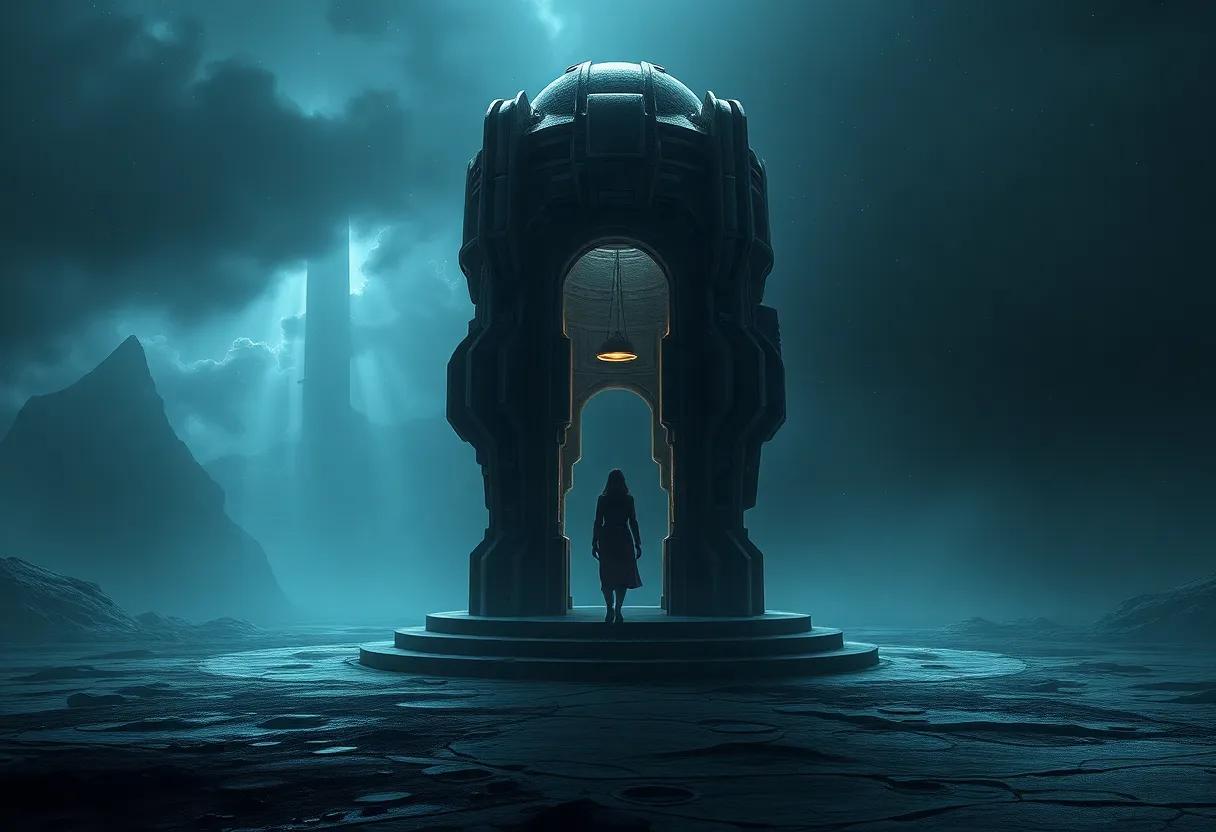In a literary landscape teeming with genre blends and boundary-pushing narratives,Stephenie Meyer’s The Host emerges as a distinctive fusion of science fiction and romance.This novel invites readers into a world where humanity’s survival intertwines with matters of the heart, challenging conventional storytelling through its unique premise. In this review, we delve into the layers of The Host, exploring how Meyer navigates complex themes of identity, love, and coexistence against an alien invasion backdrop-offering a thoughtful examination of a work that both captivates and provokes reflection.
Unraveling the Intriguing Blend of Science Fiction and Romance in The Host’s Narrative Landscape
Within the narrative fabric of The Host, Stephenie Meyer crafts an extraordinary synergy between two seemingly disparate genres-science fiction and romance. The novel defies conventional boundaries by intertwining an interstellar invasion story with the tender complexities of human emotion, creating a dynamic tension that drives the plot forward. This fusion challenges readers to explore themes such as identity, love, and coexistence beyond the constraints of Earthly realities. The science fiction elements provide a thought-provoking backdrop of alien consciousness and societal upheaval, while the romantic subplot breathes intimacy and vulnerability into the larger cosmic narrative.
What sets this novel apart is its deft balance of genre elements through:
- Multidimensional characters who navigate loyalty and self-sacrifice across species boundaries.
- A richly imagined world that blends dystopian despair with hopeful human connection.
- Themes of empathy and survival that resonate on both personal and worldwide levels.
Together, these facets illustrate a narrative landscape where the speculative and the emotional are not onyl compatible but complementary, inviting readers to reconsider what it means to love and live in an ever-changing universe.
| Element | Impact on Narrative |
|---|---|
| Alien Invasion | Establishes a high-stakes, speculative setting |
| Romantic Conflict | Introduces intimate emotional tension |
| Human-Alien symbiosis | explores identity and coexistence |
Examining the Complex Character Dynamics and emotional Depth Driving the Story Forward
At the heart of The Host lies a tapestry of relationships that push beyond conventional boundaries, crafting a narrative rich in emotional complexity. The characters are not mere archetypes in a sci-fi romance; they are intricately woven souls whose internal conflicts and evolving bonds create a compelling push and pull that propels the story. This emotional layering invites readers to consider the profound questions about identity, love, and what it means to be human when bodies and minds are no longer a singular possession. The unique dynamic between Melanie and Wanda, where two consciousnesses coexist and clash within one body, opens up a fascinating exploration of duality – a relationship both symbiotic and antagonistic.
To better understand the driving forces behind these multifaceted connections, it helps to examine key emotional catalysts in the story:
- Trust and Betrayal: The fragile negotiations between host and alien consciousness highlight the vulnerability embedded in trust.
- Love’s Transcendence: How love extends beyond physical boundaries, questioning traditional romantic norms.
- Identity Crisis: The profound struggle between self-preservation and coexistence within one body.
| Character | Emotional Conflict | Relationship Impact |
|---|---|---|
| Melanie | Fighting to reclaim her life | Catalyst for Wanda’s empathy development |
| Wanda | Balancing alien purpose with human emotions | Generates internal tension and growth |
| Jared | Conflicted feelings towards Melanie’s altered state | Deepens themes of unconditional love |
How Meyer’s World-Building Creates an Immersive and Visually vivid Sci-Fi Environment
Meyer’s intricate world-building in The Host transcends traditional sci-fi settings by weaving a tapestry rich with sensory detail and emotional nuance. The alien landscapes are not merely backdrops but living entities that shape the story’s mood and character decisions.Through vivid descriptions of the terrain-ranging from ethereal forests shimmering under twin suns to dystopian urban sprawls with labyrinthine alleyways-readers are invited to visualize and inhabit a universe that feels both alien and intensely familiar. This environmental immersion is enhanced by subtle touches such as native flora glowing in bioluminescent blues and the omnipresent hum of advanced technologies that blur the line between organic life and machinery. Meyer carefully layers these elements,allowing for a story world that engages all senses,fostering a believable and emotionally resonant experiance.
crucially, the social and political structures within this universe are crafted with equal attention, adding depth beyond visual stimuli. The interplay between the host species and their human counterparts introduces complex dynamics that ripple throughout every setting’s design.Below is a brief outline of key world-building aspects that contribute to the book’s immersive quality:
- Biomes: From lush forests to arid wastelands, each region is uniquely suited to the inhabitants’ evolutionary traits and cultural identities.
- Technology: Seamlessly integrated into daily life, with AI systems influencing both personal and societal evolution.
- Societal Norms: Nuanced customs and belief systems that challenge human perspectives and question identity.
- Language & Interaction: Invented languages and telepathic exchanges enrich the interpersonal and interspecies dialog.
| world Element | Purpose | Impact on Narrative |
|---|---|---|
| Alien Flora | Establishes setting mood | reflects characters’ emotional states |
| Cultural Rituals | Builds social tension | Drives character conflict and growth |
| technological Interfaces | Blurs lines between species | Raises questions about identity |
The Subtle Exploration of Identity and humanity Amidst Alien Possession and Coexistence
At the heart of the narrative lies a delicate dance between two consciousnesses – one human, one alien - sharing a single body. This profound interplay challenges conventional notions of selfhood, as the novel deftly peels back layers of identity to reveal a mosaic of experiences and emotions that transcend species. The alien occupier is not a mere invader but a conscious being grappling with unfamiliar human sensations: love, fear, memory. Meanwhile, the human host’s spirit clings to fragments of past autonomy, generating a tension that reframes what it means to be human in an otherworldly context. Through this symbiosis, the story illuminates how identity is fluid, shaped by both external forces and internal resilience.
Meyer subtly untangles broader themes of coexistence and empathy, inviting readers to reconsider ideas about “the other” and shared existence. Rather than a simplistic alien invasion tale, the narrative poses poignant questions:
- Can two disparate beings truly understand and respect one another from within?
- What does it mean to possess autonomy when your very body is a contested space?
- How do love and sacrifice redefine connection beyond biological boundaries?
| Aspect | Human Experience | Alien Perspective |
|---|---|---|
| Memory | Emotional residue, nostalgia | Analytical recollection |
| emotion | Complex and intuitive | emerging and curious |
| desire | Personal freedom, love | Survival, understanding |
delving into the Thought-Provoking Themes of Love, Loss, and Ethical Dilemmas Within the plot
At its core, this narrative wrestles with the complexities of love that transcends physical and existential boundaries. The intertwined lives of characters reveal that love is not merely an emotion but a catalyst for profound conversion and internal conflict. Relationships in the story frequently enough oscillate between tender connections and heartbreaking ruptures, emphasizing how love can simultaneously heal and unravel. From unexpected alliances to sacrificial decisions, the characters navigate a maze where affection challenges their very sense of identity.
Embedded within the plot are ethical quandaries that provoke the reader to consider the morality of choices under extreme circumstances. Issues such as autonomy, consent, and survival create a fertile ground for debate, inviting viewers to reflect on questions like:
- What defines true belonging?
- Is it justifiable to compromise personal freedom for collective safety?
- Where do we draw the line between empathy and exploitation?
These dilemmas underscore the layered nature of the narrative, where right and wrong blur, making every decision a profound ethical puzzle.
| Theme | Central question | Impact on Characters |
|---|---|---|
| Love | Can love survive beyond physical form? | Forces redefinition of identity |
| Loss | How does grief reshape purpose? | Drives emotional depth and resilience |
| Ethical Dilemmas | What is the price of survival? | Creates conflict and character growth |
Analyzing the Pacing and Structure that Balance Suspenseful Moments with Reflective Passages
meyer’s narrative rhythm in The Host cleverly intertwines high-stakes tension with moments of quiet introspection, creating a dynamic flow that keeps readers both engaged and emotionally invested. The story alternates between pulse-pounding sequences-such as moments of alien invasion and internal conflict-and more contemplative passages where characters wrestle with their identity,morality,and personal connections. This ebb and flow not only sustains suspense but also deepens the thematic resonance, allowing readers space to reflect on the complex human experiences beneath the sci-fi surface.
Key mechanisms that achieve this balance include:
- Varied scene length: Short,sharp scenes accelerate pace during suspenseful moments,while elongated,descriptive passages slow the tempo for reflection.
- Shifting perspectives: Alternating viewpoints add complexity and emotional depth, offering insight into both external threats and internal dilemmas.
- strategic pacing of reveals: Data is unveiled methodically, ensuring tension remains palpable without overwhelming the narrative with constant action.
| Element | Impact on Pacing | Effect on Reader |
|---|---|---|
| Action Scenes | Accelerate momentum | Heightened suspense, adrenaline rush |
| Reflective Passages | Slow pacing, purposeful | Emotional engagement, thematic depth |
| Character Introspection | Moderates speed | Insight into motives and conflicts |
the Role of Supporting Characters in Enhancing the Protagonist’s Journey and Overall Story Arc
In The Host,Stephanie Meyer crafts more than just a love story; she builds a complex interpersonal web where supporting characters do much of the heavy emotional lifting. These figures are not mere background fillers but act as catalysts for the protagonist’s growth and self-revelation. characters like Jared, Ian, and Melanie infuse the narrative with moral ambiguity and internal conflict, allowing the protagonist to navigate the tangled labyrinth of identity and loyalty. Their presence highlights the duality of humanity and alien influence, pushing the lead to reevaluate her notions of what it means to love, fight, and surrender.
The supporting cast also enriches the world-building, giving readers crucial insight into the political and psychological stakes beyond the protagonist’s personal struggle.Through their diverse perspectives and interactions, the story gains layers of complexity and a dynamic rhythm that would otherwise be absent. These elements coalesce neatly in the table below, which outlines how key supporting characters augment various facets of the story’s arc and themes:
| Character | Role in Protagonist’s Journey | Contribution to Story Arc |
|---|---|---|
| Jared | Embodies human emotion and vulnerability | Conflict between human and alien identities |
| Ian | Voice of reason and moral dilemma | Explores themes of trust and sacrifice |
| Melanie | Symbolizes resilience and inner strength | Drives the emotional heartbeat of the narrative |
- Challenge the protagonist’s beliefs: Supporting characters confront and question her identity.
- Provide emotional contrast: Through their struggles, the protagonist’s journey gains depth.
- Enrich thematic exploration: They embody different facets of the story’s central conflicts.
Assessing the Narrative Voice and Its Impact on Reader Engagement and Emotional Resonance
Meyer’s choice of narrative voice in The Host is a masterstroke that profoundly deepens the reader’s connection to the story. By opting for a first-person perspective through Melanie Stryder’s consciousness,the novel invites readers into a labyrinth of conflicting emotions and moral dilemmas. This intimate vantage point creates a dynamic interplay between the human and alien identities, revealing the layered complexity of inner struggles. The voice oscillates smoothly between vulnerability and strength, capturing the multifaceted nature of identity in a way that is both accessible and haunting. This close narrative proximity encourages readers not only to witness but to empathize with the characters’ evolving journeys, enhancing both engagement and emotional resonance.
The impact of this narrative choice extends beyond mere storytelling; it serves as the emotional engine of the novel. Through a rich blend of introspective passages and vivid descriptions,Meyer crafts moments that linger in the reader’s mind long after turning the page. Key elements that contribute to this effect include:
- Dual consciousness perspective: A unique fusion that challenges traditional character boundaries
- Conflicted loyalties: Eliciting sympathy by exploring ethical gray areas
- Lyrical prose: elevating sci-fi romance beyond genre conventions
To further illustrate the narrative’s impact, the table below outlines how different aspects of the voice foster emotional engagement:
| Narrative Element | Reader Impact | emotional Effect |
|---|---|---|
| Internal Monologue | Heightened intimacy | Empathy & understanding |
| narrative Tone | Maintains engagement | Emotional investment |
| Dual Perspectives | Invokes curiosity | Inner conflict awareness |
Visualizing the Symbolic Imagery and Metaphors That Enrich the Thematic Depth of The Host
Stephenie Meyer’s The Host thrives not only on its intricate plot and emotional resonance but also on the rich tapestry of symbolic imagery that underscores its thematic exploration. The alien souls, known as “souls,” serve as powerful metaphors for colonization and identity, prompting readers to question what forms the essence of the self. The duality between the host body and the invading consciousness becomes a visual dance of coexistence, highlighting the fragile boundaries between domination and harmony. Throughout the narrative, natural elements like rivers and forests are more than mere settings-they symbolize purification, growth, and the resilience of life amidst external disruption.
To deepen our understanding, consider these recurring symbols:
- The Desert landscape: Emblematic of isolation and the vastness of human emotions, this setting mirrors the internal desolation experienced by characters wrestling with their fractured identities.
- The Mirror Motif: Reflections emphasize themes of self-perception and the multiplicity of the soul, drawing attention to the internal conflicts and alliances formed between the human host and the alien presence.
- Bird Imagery: Representing freedom and transcendence, birds appear subtly in key scenes, reminding readers of the characters’ yearning to soar beyond imposed limitations.
| Symbol | Meaning | Scene Example |
|---|---|---|
| Desert | Isolation, emotional barrenness | Wandering during the Soul’s internal struggle |
| Mirror | Duality of identity | Moments of self-reflection and conflict |
| Birds | Freedom and hope | Escape scenes and moments of revelation |
How The Host Challenges Traditional Genre Boundaries by blending Romance and Science Fiction Elements
Stephenie Meyer’s The Host masterfully defies expectations by merging two seemingly disparate genres: romance and science fiction. Instead of relegating the love story to the background or limiting sci-fi to mere setting, meyer weaves both elements into the core narrative fabric. The novel challenges the conventional boundaries by presenting a world transformed by alien invasion, where emotional depth and complex relationships remain front and center. this fusion not only enriches character development but also adds layers of philosophical inquiry, asking readers to consider what makes us inherently human. The romance between Melanie and Jared, elaborate by the presence of the alien ‘Soul,’ offers a compelling dynamic that disrupts traditional tropes within both genres.
What sets The Host apart is its ability to balance the speculative with the intimate. Through a narrative crafted with care,the book explores:
- Identity and coexistence: blending the intimate struggle of dual consciousness with the broader sci-fi theme of invasion
- Emotional complexity: a love triangle that transcends biological and species boundaries
- Philosophical dilemmas: questioning morality,free will,and the essence of the soul within a science-fiction framework
This synthesis breaks free from genre clichés,inviting readers into a world where emotional resonance and futuristic speculation exist in harmonious balance.
| Genre Element | Traditional Role | The Host innovation |
|---|---|---|
| Romance | Secondary, frequently enough subplot | Central driver of plot and character conflict |
| Science Fiction | World-building and action | Philosophical foundation with emotional stakes |
| Character Dynamics | Human focus | Human-alien coexistence and inner duality |
Reflecting on the Book’s Contemporary Relevance and Its Commentary on Society and Human Nature
“The Host” transcends the boundaries of its sci-fi romance genre by delving deep into themes that resonate profoundly with contemporary society. At its core, the novel explores the delicate balance between identity and coexistence, prompting readers to consider what it truly means to belong. Meyer’s portrayal of a world where parasitic aliens inhabit human bodies sparks reflection on issues such as cultural assimilation, empathy, and the ethical dilemmas posed by invasive forces, both literal and metaphorical. These layers of meaning invite a dialogue about our collective fears and hopes amidst rapidly changing social landscapes.
The narrative also offers a poignant commentary on human nature, revealing vulnerabilities and strengths that shape our interactions. Through its unique characters, the story highlights:
- The resilience of the human spirit in the face of overwhelming odds.
- The complexity of identity when external and internal voices collide.
- The necessity of empathy to bridge seemingly insurmountable divides.
By weaving these elements together, Meyer crafts a thought-provoking mirror reflecting how humanity grapples with change, trust, and unity. The novel’s relevance is further underlined when considering societal challenges today, making “The Host” a timeless exploration of coexistence and understanding.
| Theme | Societal Reflection | Human Nature Insight |
|---|---|---|
| Identity | Immigration & Assimilation | Inner conflict & Choice |
| coexistence | Multiculturalism & Diversity | Empathy & Cooperation |
| Control & Freedom | Surveillance & Autonomy | resistance & Willpower |
Specific Recommendations for Readers Seeking a Thoughtful and Emotionally Engaging Sci-Fi Romance
For readers craving a sci-fi romance that transcends typical genre boundaries, “The Host” offers a deeply reflective and emotionally charged narrative. This novel is ideal for those who appreciate complex character development intertwined with thought-provoking themes such as identity, connection, and sacrifice. the romance blossoms not just through simple attraction, but through the collision of two distinct worlds inside one body-leading to moments of poignant tension and heartfelt intimacy. Fans of stories that challenge the conventional roles of love and selfhood will find themselves immersed in a universe where emotions are as alien as the outer space backdrop.
When delving into this experience,consider keeping these recommendations in mind to enrich your engagement:
- Focus on the subtle shifts in perspective as the narrative alternates between human and alien consciousness.
- Reflect on the ethical dilemmas raised by coexistence and consent.
- Appreciate the lyrical prose that gracefully balances scientific speculation with emotional depth.
- Embrace the slow-burning romance that defies typical sci-fi action tropes.
| Element | Why it Matters |
|---|---|
| Dual Narratives | Engenders empathy through contrasting viewpoints. |
| Moral Ambiguity | Challenges traditional black-and-white notions of good vs evil. |
| Emotional Intimacy | Offers a nuanced portrayal of love beyond physical attraction. |
Introducing Stephenie Meyer as a Writer Who Bridges Genre Divides with Imaginative and Compassionate Storytelling
Stephenie Meyer, widely known for her Twilight saga, steps beyond traditional genre boundaries with The Host, crafting a narrative that is as imaginative as it is heartfelt. This novel deftly blends speculative science fiction with a tender romance, inviting readers into a world where alien invasions are not just battles of strength but also of empathy and understanding. Meyer’s ability to humanize extraterrestrial experiences challenges conventional sci-fi tropes,offering a story rich in emotional complexity and philosophical questions about identity and coexistence.
Through layered characterization and evocative prose, The Host explores themes of memory, love, and the ethical dilemmas of survival. The novel’s unique premise provides a canvas where readers can contemplate the nature of the self amidst extraordinary circumstances. below is a snapshot showcasing some of the compelling aspects that position The Host as a standout work across genres:
| Aspect | Details |
|---|---|
| Genre Blend | Science Fiction & Romance |
| Central Conflict | Alien invasion vs. human heart |
| Key Themes |
|
| Narrative Style | Intimate and Reflective |
The Host stands as a compelling fusion of science fiction and romance, inviting readers to ponder the complexities of identity, love, and humanity through Meyer’s unique lens. Whether you’re drawn to the genre’s speculative allure or the tender emotional currents beneath, this novel offers a thoughtful journey that lingers long after the final page. Unveiling its layers reveals not just a story of otherworldly invasion, but a nuanced meditation on the ties that bind us-all wrapped in an imaginative narrative that challenges as much as it enchants.










